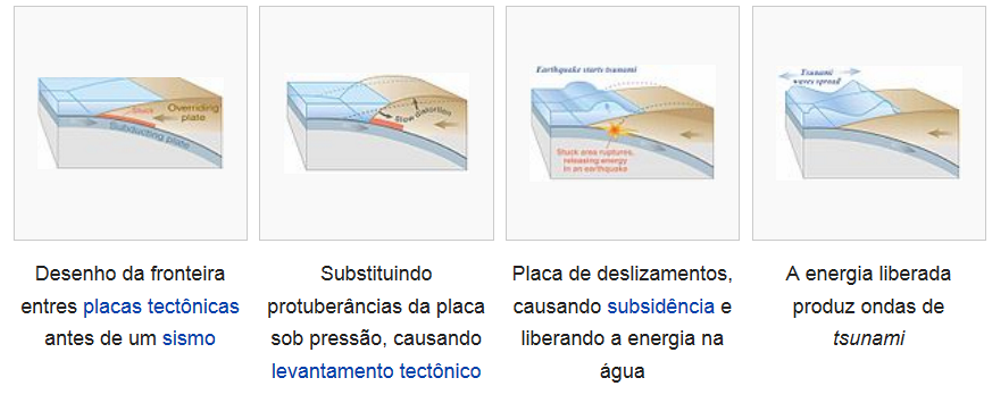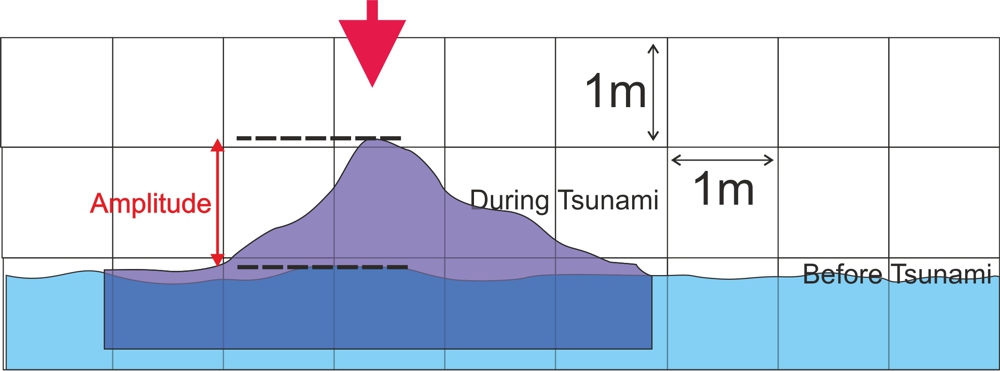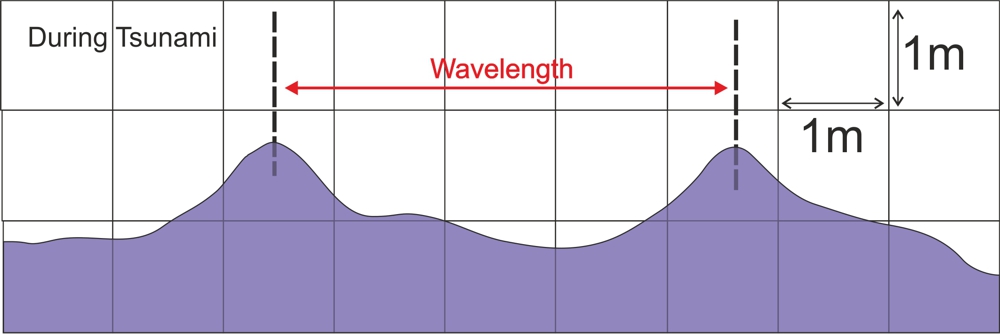|

Etimologia: Um tsunami ou maremoto (do latim: mare, mar + motus, movimento) é uma série de ondas de água causada pelo deslocamento de um grande volume de um corpo de água, como um oceano ou um grande lago. Devido aos imensos volumes de água e energia envolvidos, tsunamis podem devastar regiões costeiras.
Sismos, erupções vulcânicas e outras explosões submarinas (detonações de artefatos nucleares no mar), deslizamentos de terra e outros movimentos de massa, impactos, e outros distúrbios acima ou abaixo da água têm o potencial para gerar um tsunami.
Características: As ondas geradas por ventos corriqueiros e ondas de gravidade têm um comprimento de onda (comprimento entre as cristas) de cerca de 100 metros e uma altura de alguns centímetros. Entretanto, um tsunami em alto mar tem um comprimento de onda de cerca de 200 km. Essa onda pode viajar a mais de 800 km/h, mas devido ao seu grande comprimento de onda, seu período (intervalo de tempo entre a passagem de uma crista e outra no mesmo local) pode durar de 20 a 30 minutos, e a amplitude de onda pode não passar de um metro.9 Isso torna difícil a detecção de tsunamis em águas profundas. Navios raramente notam a sua passagem.
À medida que o tsunami se aproxima da costa e as águas se tornam menos profundas, o empolamento da onda comprime a própria onda e sua velocidade diminui para menos de 80 km/h. Seu comprimento de onda diminui para menos de 20 km e sua amplitude cresce significativamente, produzindo uma onda claramente visível. Com o advento do tsunami sobre águas cada vez mais rasas, a velocidade da onda diminui pouco a pouco, podendo desacelerar para menos de 20 km/h. Seu comprimento de onda pode diminuir para apenas alguns metros e sua amplitude pode alcançar mais de 10 metros; a altura da onda pode variar dependendo da intensidade do tsunami e do relevo da plataforma continental.

Esta EarthCache:
Tsunamis são muito perigosos para estudar sem equipamento sofisticado e sem convidar danos e lesões. No entanto, um laboratório natural é o ambiente ideal para estudar estes fenómenos.
Portanto, este EarthCache leva-te a um laboratório natural para ver mini tsunamis geradas por uma erupção vulcânica e estás convidado a responder às seguintes perguntas:
Vais precisar de um cronómetro e fita métrica para as próximas tarefas.
1- Se o vulcão é o epicentro, até que distância pode o tsunami gerado pela erupção mover antes de encontrar um obstáculo? A resposta deve ser enviada em metros, por exemplo, 2,34 m.
2 – Qual o tempo total que leva a onda para viajar de epicentro ao obstáculo? (a resposta deve ser dada em segundos)
3 - Usando a equação de velocidade (V = d / t), em que, V = velocidade, d = distância (em metros) e t = tempo (em segundos), calcula a velocidade do tsunami. A resposta será em m / s.
Vais precisar de tirar fotos (isto é OPCIONAL - podes concluir este passo sem fotografias mas é mais fácil com) para o próximo conjunto de tarefas.
4 - Ampliando escala dos azulejos para representar 1x1m, mede a amplitude de onda do tsunami. Nota: precisas de uma foto de referência antes do tsunami e uma durante o tsunami para comparação - Essa é a sua amplitude. (Por favor, dê a resposta em metros ou fracções de metros).

5- Mais uma vez, ampliando a escala tal como na tarefa anterior, mede o comprimento de onda do tsunami. Nota: precisa de uma referência de dois picos de onda para depois comparar a distância entre os dois picos de onda – Esse intervalo é o seu comprimento de onda. (Por favor, dá a resposta em metros ou fracções de metros)

Caso a actividade tectónica esteja calma e não consigam fazer as respectivas medições, por favor indiquem a altura do vulcão e a sua circumferência.
Nota
É incrível que, em visitas separadas, em dias totalmente distinctos, ao longo dos últimos meses, eu recebi respostas que são EXACTAMENTE iguais para esta cache; mesmo quando o vulcão não está a funcionar! Agora, ou todos estão a usar os seus poderes psíquicos para obter as respostas para esta cache, ou .......
Portanto, a partir de 6 de junho de 2019, existe uma TAREFA ADICIONAL para validar o registo nesta EC:
Uma foto tua, do teu nick num pedaço de papel, escrito no braço, escrito na perna ou em qualquer outra parte do corpo na frente do vulcão é necessária para validar sua descoberta.
Quem não colocar a imagem, sujeita-se que o registo seja apagado!
Enviem-me as respostas para o mail leinadoligc@gmail.com . Caso as respostas estejam correctas o log mantem-se, caso não, serão contactados posteriormente.

Etymology: The term tsunami comes from the Japanese and is composed of tsu meaning "harbour" and nami, meaning "wave".
Characteristics: Tsunami waves do not resemble normal sea waves, because their wavelength is far longer. Rather than appearing as a breaking wave, a tsunami may instead initially resemble a rapidly rising tide, and for this reason they are often referred to as tidal waves. Tsunamis have a small amplitude (wave height) offshore, and a very long wavelength (often hundreds of kilometres long, whereas normal ocean waves have a wavelength of only 30 or 40 m), which is why they generally pass unnoticed at sea, forming only a slight swell usually about 300 mm above the normal sea surface. They grow in height when they reach shallower water, in a wave shoaling process described below.
Tsunamis generally consist of a series of waves with periods ranging from minutes to hours, arriving in a so-called "wave train". Wave heights of tens of metres can be generated by large events. Although the impact of tsunamis is limited to coastal areas, their destructive power can be enormous and they can affect entire ocean basins.
Generating mechanism: Tsunamis cause damage by two mechanisms: the smashing force of a wall of water travelling at high speed, and the destructive power of a large volume of water draining off the land and carrying a large amount of debris with it, even with waves that do not appear to be large.
The principal generation mechanism (or cause) of a tsunami is the displacement of a substantial volume of water or perturbation of the sea. This displacement of water is usually attributed to earthquakes, landslides, volcanic eruptions, and glacier calvings or more rarely by meteorites and nuclear tests. The waves formed in this way are then sustained by gravity. Tides do not play any part in the generation of tsunamis. This EarthCache focuses on the tsunamis generated by volcanic eruptions

- Volcanic Eruption - Although relatively infrequent, violent volcanic eruptions represent also impulsive disturbances, which can displace a great volume of water and generate extremely destructive tsunami waves in the immediate source area. Volcanic disturbances can generate waves by the sudden displacement of water caused by a volcanic explosion, by a volcano's slope failure, or more likely by a phreatomagmatic explosion and collapse and/or engulfment of the volcanic magmatic chambers. The majority of tsunamis that occur in the Pacific Ocean happen around the “Ring of Fire” Area surrounding the Hawaiian Islands. The periphery has also been dubbed the 'Ring of Fire' because of the extraordinarily high number of active volcanoes and seismic activity located in the region. Since 1819, over 40 tsunamis have struck the Hawaiian Islands. One of the largest and most destructive tsunamis ever recorded was generated in August 26, 1883 after the explosion and collapse of the volcano of Krakatoa (Krakatau), in Indonesia. This explosion generated waves that reached 135 feet, destroyed coastal towns and villages along the Sunda Strait in both the islands of Java and Sumatra, killing 36, 417 people.
This EarthCache:
Tsunamis are far too dangerous to study without sophisticated equipment and without inviting harm and injury. However, as most sciences do, a natural laboratory is the best environment to study these pehenomena.
Therefore, this EarthCache takes you to a natural laboratory to see miniature tsunamis generated by a volcanic eruption and you are invited to answer the following questions:
You will need a stopwatch and measuring tape for the next tasks.
1-Taking the volcano as the epicenter, how far can the tsunami generated by the eruption generated travel before it meets an obstacle? The answer must be sent in metres, e.g. 2.34 m.
2- What is the total time that it takes the wave to travel from epicenter to stopping wall?
3- Using the equation for speed/velocity (V=d/t) where, V= velocity, d= distance and t= time, calculate the speed of the wave as it travels from source to stopping wall. Your answer will be in m/s.
You will need to take pictures (this is OPTIONAL - it is merely a tool used to make it easier to read the height of the wave) for the next set of tasks.
4-Blowing up the scale of the confining tiles to represent 1x1m, measure the amplitude of the tsunami. Note: you need a reference photo BEFORE the tsunami and one DURING the tsunami and compare the difference in both – That is your amplitude. (Please give the answer in metres).

5-Once again, blowing up the scale of the confining tiles to represent 1x1m, measure the wavelength of the tsunami. Note: you need a reference of two wave peaks and compare the distance between both wave peaks – That is your wavelength. (Please give the answer in metres)

In case tectonic activity is at a minimum and you cannot measure the above parameters, please tell me the height of the volcano as well as its circunference.
Note
It's amazing that on separate visits, on totally distinct days, over the last few months, I receive answers that are ALL EXACTLY alike for this cache. Even when the volcano is NOT WORKING! Now, either everyone is tapping in to some psychic power to obtain the answers to this cache, or ....... Therefore, from 6 june 2019 there is an ADDITIONAL TASK to validate the find in this EC:
A picture of you, of your nick on a piece of paper, on your arm, leg, or whatever in front of the volcano is necessary to validate your find. No picture = log deletion!
Please send the answers to these tasks to leinadoligc@gmail.com . If they’re correct, your log will stand and you won’t hear from me, otherwise be sure that you will contacted.
Source material
http://neamtic.ioc-unesco.org/what-to-know/the-causes-of-tsunamis
http://en.wikipedia.org/wiki/Tsunami
Papadopoulos, GA & Imamura, F, 2001. A proposal for a new tsunami intensity scale. ITS Proceedings, pg.569-577.
http://www.tsunami.noaa.gov/
http://ptwc.weather.gov/

|